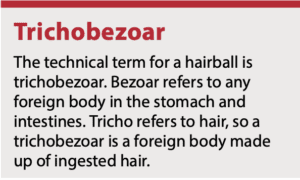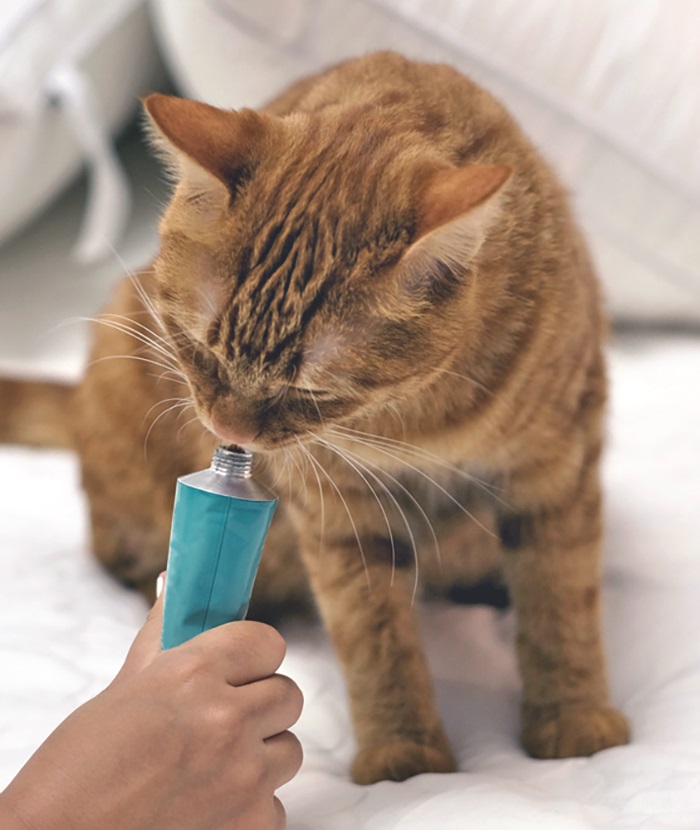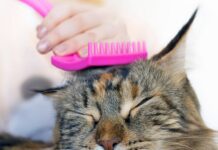Cats have a natural fastidious need to groom and tongues that have papillae spikes, which cause the rough feel when your cat licks you. These spikes are superb at removing loose hair, and while daily grooming is a normal part of being a cat, most cats do not end up throwing up wads of this undigested hair, known as hairballs.
While grooming, this loose hair hair is swallowed, and much of it ends up in your cat’s GI tract, where it can clump together to form hairballs. While primarily considered a feline problem, rabbits and dogs also can experience hairball buildup.
In an informal survey reported by the American Association of Feline Practitioners, only 10% of short-haired cats brought up two or more hairballs a year, 17% once a year, and 73% never brought up hairballs. Long-haired cats were twice as likely to throw up a hairball than short haired cats.
 Signs of a Problem
Signs of a Problem
Despite what is commonly believed, hairballs are not normal, especially if seen more often than every two months or so, says Leni Kaplan, DVM, senior lecturer in the community practice service at Cornell University’s College of Veterinary Medicine.
Cats that are predisposed to hairballs often have other underlying conditions such as overgrooming and gastrointestinal disease, which is why cats that tend to vomit hairballs frequently should be seen by their primary-care veterinarian.
Cats may overgroom because they’re itchy due to ectoparasites like fleas or mites, or because they have allergies. Underlying gastrointestinal disease can cause delayed stomach emptying, which causes the hair to accumulate in the stomach until it is expelled as a hairball, or the cat may be battling inflammatory bowel disease.
A workup for frequent hairball vomiting starts with an exam and history. Your veterinarian will want to rule out external parasites and allergies that trigger increased grooming. Behavioral conditions that may lead to anxious over-grooming should also be considered as a cause.
Palpation can reveal large amounts of wadded hair stuck in the stomach. A fecal sample can turn out to be mainly hair, and some cats can even become constipated from large amounts of hair in the gastrointestinal tract.
Bloodwork will look at chronic illnesses that may reduce gastric motility. An X-ray or ultrasound may help your veterinarian identify a hairball and rule out other problems.
Large hairballs may block the pylorus of the stomach so food and the ingested hair can’t be passed into the intestines. It is rare for a hairball to cause an obstruction in the intestines, but this can happen and is a serious situation that often requires surgery if it does.
Prescription medications such as metoclopromide or off-label use of cisapride may enhance gastric and intestinal motility. Since hair is primarily keratin and not digestible, these medications can help your cat to pass the swallowed hair.
What You Can Do
If your cat has a hairball problem, the first step is to get the ingested hair to move through the intestinal tract. There are over-the-counter hairball products that are basically lubricants that can ease the passage of the hair. Some commercial foods marketed as special feline hairball diets rely upon extra fiber to help move things along.
“The only home treatment I can recommend is making sure the cats have a high water content in their diet to help keep food moving through their intestinal tract,” says Dr. Kaplan. “Canned food diets are great. Owners can even add a bit of water to the canned food, so it is more soupy.”
Prevention
Preventing a hairball problem basically comes down to treating any underlying causes such as parasites and anxiety while focusing on regular grooming with a brush and/or comb. The more hair you remove, the less your cat can ingest.
“Grooming is indeed the best way to prevent hairballs,” says Dr. Kaplan. “Some cats need to be brushed daily while others can be brushed a few times per week. If grooming is not an option or if the cat is long-haired, the owner can take the cat to a groomer and get a lion cut two or three times per year to help prevent hairballs.”ν
Robert Way | iStock
Over-the-counter lubricants are a good first step, but if they don’t help, seek veterinary help sooner rather than later.




